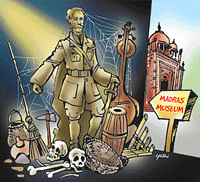
When ‘history’ gets pushed into the realm of ‘anthropology’, one can well imagine the resentment and outrage that must have quietly legitimised it, more so with statues of erstwhile British rulers. Perhaps Col James Neil’s statue is no exception to this unwritten rule as his gigantic figure sculpted in bronze has been languishing for long years, in the ‘anthropology section’ of the Madras Museum at Chennai.
Except for the Museum staff very few from the outside world must have had an opportunity to see the statue of that notorious British Army officer, ever since it was carted into the complex way back in 1952.
After being removed from Chennai’s public space, bowing to nationalist sentiments, when the late C Rajagopalachari became the first ‘Premier’ of the erstwhile Madras Presidency in 1937, by a resolution of the then Madras Corporation, Neil’s statue was kept for some years in the ‘Ripon Buildings complex’ in Park Town area of the city which houses the City Corporation.
“In 1952, Neil’s statue was formally handed over to the Madras Museum,”
recalls an official. And then for many years, it has safely been under lock and key in the Anthropology Section, he says.
That section itself has not been open to public viewing since the mid-1995. Thus the much-hated Army officer, clearly one of the biggest statues in the Museum measuring over 10 feet in height, has been keeping company for at least over a decade now with pre-historic stones, tribal objects, old musical instruments including folk arts, and objects of physical anthropology like a skull of the early man. The reason was that the section was shut down for renovation and the work has just got over.
“There has been nobody to take an active interest after Dr Devasahayam, an eminent scholar and curator of the Madras Museum who retired in the late 1990s,” remarked another official. Most people now may not have even heard of Neil, had it not been for a rare document on him displayed at the ‘Madras Week’ celebrations recently.
Neil’s statue is a huge presence in the Anthropology section with a plaque behind it giving details about how he led his military campaign against the ‘1857 Uprising’ and from where he raised his soldiers on the way. “He (Neil) killed one lakh Indians just for uttering the word ‘Independence’, and how can we forget that?” fumes Mr. Kalathi, Educational Officer at the Madras Museum.
On an average, the number of visitors to the Madras Museum daily is about 650 including foreigners (August 2010 figures) and it is the latter who take a keen interest in viewing statues of historical personages. For all the controversy surrounding Neil, his statue might at last see the light of day for a whole new generation of Indians, when the renovated Anthropology section will in all probability be thrown open to the public in October.
Col James Neil of the ‘Madras Fusiliers’, a European unit, commanding at Allahabad then, who was summoned from Madras after the Mutiny broke out in 1857, had with “ruthless and horrible” methods quelled the mutineers, ordering “entire villages to be burnt down and inhabitants hanged” as he marched towards Cawnpore (Kanpur).
Neil was killed in combat at Lucknow in September 1857. The British rulers then chose to honour him by erecting a statue of him on arterial Mount Road in (then) Madras in 1860. The inscription on the pedestal of Neil’s statue read: “Universally acknowledged as the first who stemmed the torrent of rebellion in Bengal.” Thus records the ‘Madras Hand Book 1871’, a rare testimony to the horrific side of India’s 1857 uprising that saw Hindus and Muslims united in their struggle against the colonial power.
Decades later when nationalist fervour swept through Madras Presidency, the ‘Tamil Nadu Volunteer Corps’ began an agitation to remove the statue of the notorious British Military officer whom they condemned as the ‘Butcher of Allahabad’.
During a visit to Madras in September 1927, Mahatma Gandhi “lent his support” to the demand but with a condition that the agitators strictly adhere to the principles of ‘Satyagraha’. Several resolutions were moved in the Madras Legislative Council to remove Neil's statue, but to no avail.
The nationalists had to wait till 1937 when under the first Rajaji-led Congress Ministry then, the Madras Corporation through a resolution ordered the removal of Neil’s statue and placed it in the Madras Museum. (The first-ever election to the newly-constituted Provincial Legislative Assemblies under the ‘Government of India Act, 1935’ , was held in 1937.)